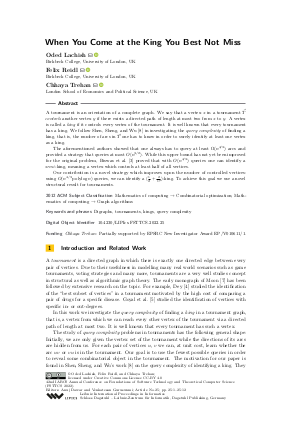When You Come at the King You Best Not Miss
Authors
Oded Lachish  ,
Felix Reidl
,
Felix Reidl  ,
Chhaya Trehan
,
Chhaya Trehan 
-
Part of:
Volume:
42nd IARCS Annual Conference on Foundations of Software Technology and Theoretical Computer Science (FSTTCS 2022)
Part of: Series: Leibniz International Proceedings in Informatics (LIPIcs)
Part of: Conference: IARCS Annual Conference on Foundations of Software Technology and Theoretical Computer Science (FSTTCS) - License:
 Creative Commons Attribution 4.0 International license
Creative Commons Attribution 4.0 International license
- Publication Date: 2022-12-14
File

PDF
LIPIcs.FSTTCS.2022.25.pdf
- Filesize: 0.63 MB
- 12 pages
Document Identifiers
Subject Classification
ACM Subject Classification
- Mathematics of computing → Combinatorial optimization
- Mathematics of computing → Graph algorithms
Keywords
- Digraphs
- tournaments
- kings
- query complexity
Metrics
- Access Statistics
-
Total Accesses (updated on a weekly basis)
0Document
0Metadata
Abstract
A tournament is an orientation of a complete graph. We say that a vertex x in a tournament T controls another vertex y if there exists a directed path of length at most two from x to y. A vertex is called a king if it controls every vertex of the tournament. It is well known that every tournament has a king. We follow Shen, Sheng, and Wu [Jian Shen et al., 2003] in investigating the query complexity of finding a king, that is, the number of arcs in T one has to know in order to surely identify at least one vertex as a king.
The aforementioned authors showed that one always has to query at least Ω(n^{4/3}) arcs and provided a strategy that queries at most O(n^{3/2}). While this upper bound has not yet been improved for the original problem, [Biswas et al., 2017] proved that with O(n^{4/3}) queries one can identify a semi-king, meaning a vertex which controls at least half of all vertices.
Our contribution is a novel strategy which improves upon the number of controlled vertices: using O(n^{4/3} polylog n) queries, we can identify a (1/2+2/17)-king. To achieve this goal we use a novel structural result for tournaments.
Cite As Get BibTex
Oded Lachish, Felix Reidl, and Chhaya Trehan. When You Come at the King You Best Not Miss. In 42nd IARCS Annual Conference on Foundations of Software Technology and Theoretical Computer Science (FSTTCS 2022). Leibniz International Proceedings in Informatics (LIPIcs), Volume 250, pp. 25:1-25:12, Schloss Dagstuhl – Leibniz-Zentrum für Informatik (2022)
https://doi.org/10.4230/LIPIcs.FSTTCS.2022.25
BibTex
@InProceedings{lachish_et_al:LIPIcs.FSTTCS.2022.25,
author = {Lachish, Oded and Reidl, Felix and Trehan, Chhaya},
title = {{When You Come at the King You Best Not Miss}},
booktitle = {42nd IARCS Annual Conference on Foundations of Software Technology and Theoretical Computer Science (FSTTCS 2022)},
pages = {25:1--25:12},
series = {Leibniz International Proceedings in Informatics (LIPIcs)},
ISBN = {978-3-95977-261-7},
ISSN = {1868-8969},
year = {2022},
volume = {250},
editor = {Dawar, Anuj and Guruswami, Venkatesan},
publisher = {Schloss Dagstuhl -- Leibniz-Zentrum f{\"u}r Informatik},
address = {Dagstuhl, Germany},
URL = {https://drops.dagstuhl.de/entities/document/10.4230/LIPIcs.FSTTCS.2022.25},
URN = {urn:nbn:de:0030-drops-174177},
doi = {10.4230/LIPIcs.FSTTCS.2022.25},
annote = {Keywords: Digraphs, tournaments, kings, query complexity}
}
Author Details
Funding
- Trehan, Chhaya: Partially supported by EPSRC New Investigator Award EP/V010611/1.
References
-
Miklós Ajtai, Vitaly Feldman, Avinatan Hassidim, and Jelani Nelson. Sorting and selection with imprecise comparisons. In International Colloquium on Automata, Languages, and Programming, pages 37-48. Springer, 2009.

-
Ramachandran Balasubramanian, Venkatesh Raman, and G Srinivasaragavan. Finding scores in tournaments. Journal of Algorithms, 24(2):380-394, 1997.

-
Arindam Biswas, Varunkumar Jayapaul, Venkatesh Raman, and Srinivasa Rao Satti. The complexity of finding (approximate sized) distance-d dominating set in tournaments. In Mingyu Xiao and Frances Rosamond, editors, Frontiers in Algorithmics, pages 22-33, Cham, 2017. Springer International Publishing.

-
Palash Dey. Query complexity of tournament solutions. In Proceedings of the AAAI Conference on Artificial Intelligence, volume 31, 2017.

-
Dishant Goyal, Varunkumar Jayapaul, and Venkatesh Raman. Elusiveness of finding degrees. Discrete Applied Mathematics, 286:128-139, 2020.

-
HG Landau. On dominance relations and the structure of animal societies: III the condition for a score structure. The bulletin of mathematical biophysics, 15(2):143-148, 1953.

-
John W Moon. Topics on tournaments in graph theory. Courier Dover Publications, 2015.

- Jian Shen, Li Sheng, and Jie Wu. Searching for sorted sequences of kings in tournaments. SIAM J. Comput., 32(5):1201-1209, 2003. URL: https://doi.org/10.1137/S0097539702410053.
